Nationality Italian Name Paolo Ruffini | Role Mathematician Fields Mathematics | |
 | ||
Education University of Modena and Reggio Emilia Parents Basilio Ruffini, Maria Francesca Ippoliti People also search for Basilio Ruffini, Maria Francesca Ippoliti, Ettore Bortolotti | ||
Gta v gameplay 4 frank matano paolo ruffini
Paolo Ruffini (September 22, 1765 – May 10, 1822) was an Italian mathematician and philosopher.
Contents

By 1788 he had earned university degrees in philosophy, medicine/surgery, and mathematics. Among his work was an incomplete proof (Abel–Ruffini theorem) that quintic (and higher-order) equations cannot be solved by radicals (1799), and Ruffini's rule which is a quick method for polynomial division. Ruffini also made contributions to group theory in addition to probability and quadrature of the circle.

He practiced as both a professor of mathematics (University of Modena) and a doctor including scientific work on typhus.
Paolo Ruffini
Group Theory
Ruffini’s 1799 work marked a major development for group theory. Ruffini developed Joseph Louis Lagrange's work on permutation theory, following 29 years after Lagrange’s "Réflexions sur la théorie algébrique des equations" (1770–1771) which was largely ignored until Ruffini who established strong connections between permutations and the solvability of algebraic equations. Ruffini was the first to controversially assert the unsolvability by radicals of algebraic equations higher than quartics. This angered many members of the community such as Malfatti (1731–1807). Work in this area was later carried on by those such as Abel and Galois who succeeded in such a proof.
